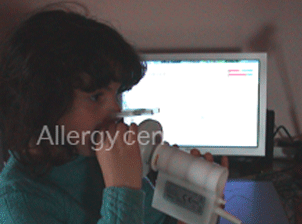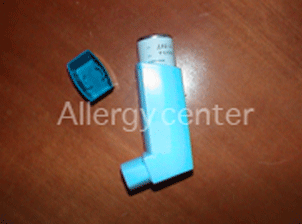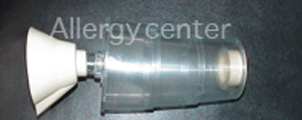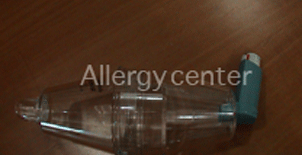Asthma is a chronic respiratory disease most common in children (10% of children are asthmatic). It is very common in adults as it affects about 6% of the general population. Allergy is the most common cause.
How is the disease ?
The disease is characterized by intermittent difficulty breathing, during which the patient will feel chest tightness, air hunger with a feeling of a locked chest, wheezing may be heard at a distance, anxiety and sometimes coughing. These crises breathing difficulties occur most often at night or after exposure to allergens. Intensity is variable, as well as their duration. These asthma attacks are caused by muscle contraction and inflammation of the bronchi, the wall is narrowed, explaining the difficulty of the passage of air into the lungs.
Triggers of crises :
Bronchi of asthmatics are easily irritated by several factors:
Contact with the allergen
Inhalation of strong odors and / or toxic cigarette smoke, bleach, exhaust, insecticides, paints, perfumes …
Viral or bacterial infections
Taking certain medications: aspirin or anti-inflammatory drugs, medicines against hypertension, some drops …
Ingestion of food in which the patient is allergic
A hearty meal or alcohol.
A strong emotion.
Physical activity practiced especially when the air is cool and dry. This form is very common in children is called exercise-induced asthma.
These triggers vary from one patient to another and from one person.
Asthma can be occasional or persistent
Some patients experience occasional crises triggered under specific conditions (workplace, contact an animal, walk in the countryside …) it is called intermittent asthma.
Other patients have symptoms throughout the year. This is called persistent asthma may be more or less severe.
How to diagnose asthma ?
The diagnosis of asthma, guided by the presence of attacks of breathing difficulties with wheezing, must be confirmed by the study of breath by the so-called spirometry.
This one is usually normal outside attacks, but if it is done at the time of the attack, there is a shortness of breath, witness the reduction of airway caliber

It is important to complete a bronchodilator test, which assesses the response of the airways to inhaled substances can raise the bronchial spasm.
In many cases, it is necessary to perform a study of bronchial reactivity following inhalation of substances known to cause broncho-constriction. The test carried out on the request of the physician, allows confirmation of the diagnosis in cases where it is doubtful.
Prick tests will seek allergic etiology.
TUNISIAN CENTER FOR EXPLORATION OF ALLERGIC DISEASES
How to treat asthma ?
Management of asthma has several components:
Avoidance of triggers
Improvement of environmental conditions: allergen avoidance, foreclosure pollutants which tobacco smoke, air and sunshine regularly
Adherence: Asthma is a chronic disease, including in particular a quasi-constant inflammation of the bronchial tree, which can occur on bronchospasm in times of crisis, it is essential that the patient understands the treatment comprises:
A basic treatment :
it relies primarily on inhaled corticosteroids. This treatment should be taken regularly by the patient and this even when he is not symptomatic, to reduce the maximum airway inflammation

Treatment of the attacks, based on the prescription of bronchodilators. If the attack is severe, oral or parenteral corticosteroids should be prescribed. Hospitalization should be considered in the absence of improvement.
Most asthma drugs are administered by inhaler system. It works on the principle of aerosol we use daily (insecticides, deodorants, …). Aerosols dispensers have the advantage of giving the maximum efficiency for a minimum of side effects which makes the drugs of choice.

However, MDIs require good synchronization between the outlet of the product and deep inspiration. This synchronization requires a good understanding of the technique by the patients. Unfortunately, even after specific training, the technique is not mastered by many patients, especially by children.
Terms of use of an inhaler:
Exhale slowly through the mouth,
Inspire slowly triggering the inhaler
Continue to build until the end
Hold your breath for about 10 seconds.
When the aerosol is misused too small amount of product reaches the lungs, and the efficacy of treatment is reduced. For asthmatics who have difficulty using inhalers, there are systems facilitating inhalation.
The rooms inhalation
Coupled with the inhaler, they allow the facilitate the inhalation.
A spacer is interposed between the inhaler and the mouth.
The drug is supplied to the chamber by pressing the aerosol, it diffuses into the tank, and is inhaled by the patient breathing quietly into the mouthpiece.
This system eliminates handling errors due to poor hand-eye coordination mouth. It is often necessary to treat asthma in childs.


The dry powder inhalers: The drug is packaged in this case in the form of dry powder, which is released by perforation of a capsule or blister. A deep breath of the powder can send it to the lungs where it is deposited.
Unlike the inhaler, this system does not require special hand-mouth coordination, and is therefore easy to use. However, the patient must have sufficient ability to inspire
Nebulizers: these are devices that can propel the medication. They lead to using a dose of active ingredient more important for efficiency comparable to other inhalation systems. They are easy to use because they require no synchronization on the part of the patient, and they can be used even in cases of severe obstruction.
The disease surveillance based on regular monitoring among physicians next to a self-monitoring through regular measurements of breath by a peak flow meter.